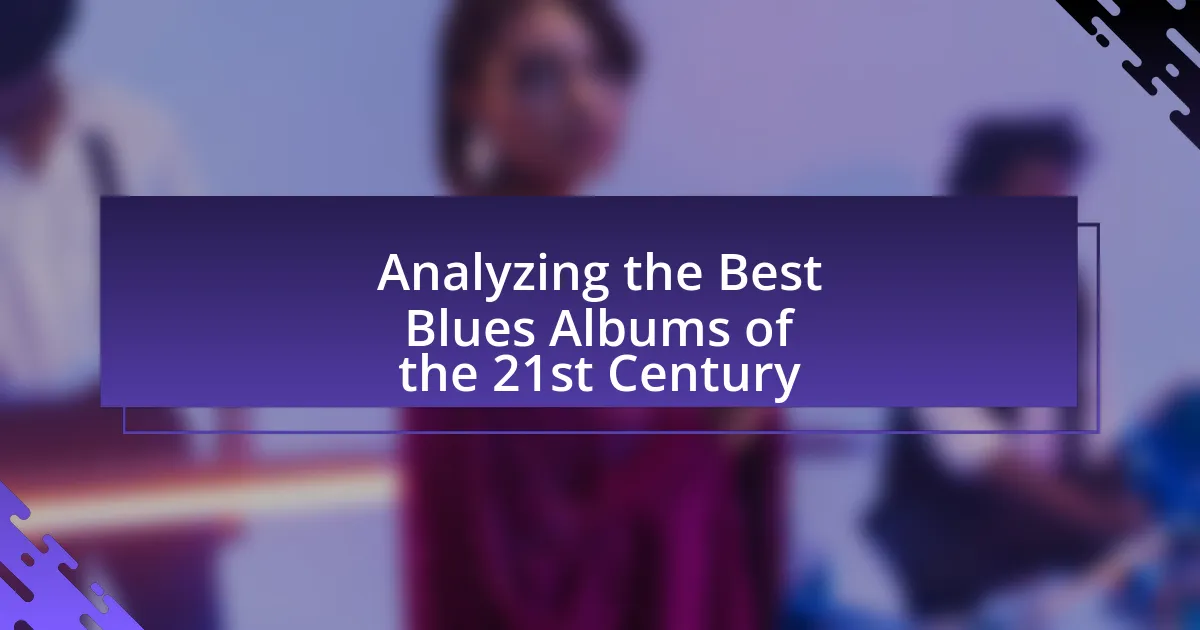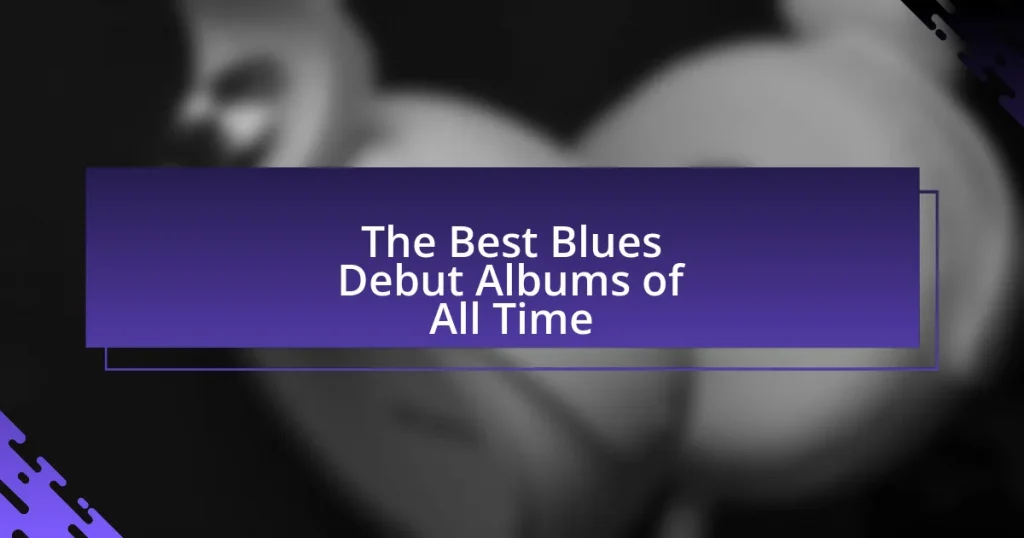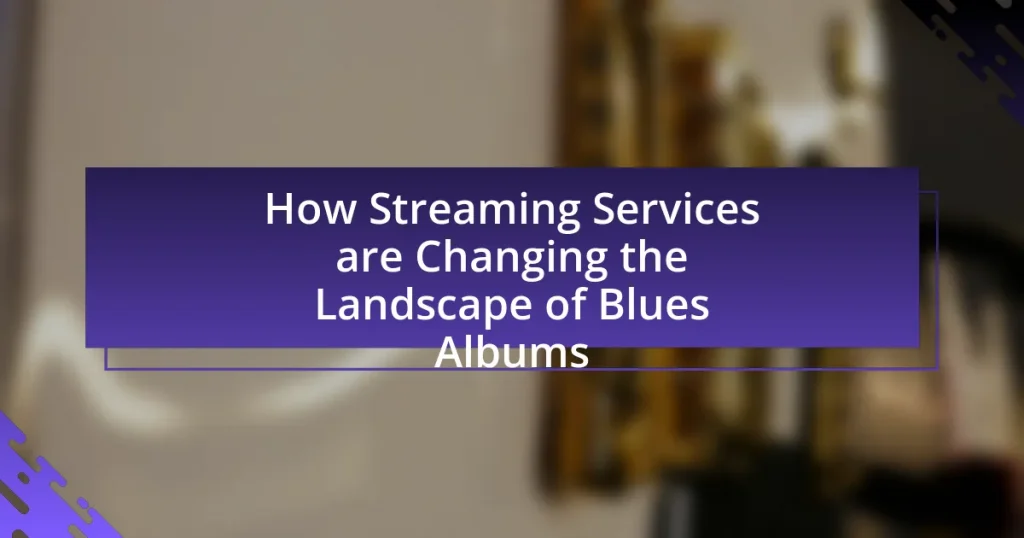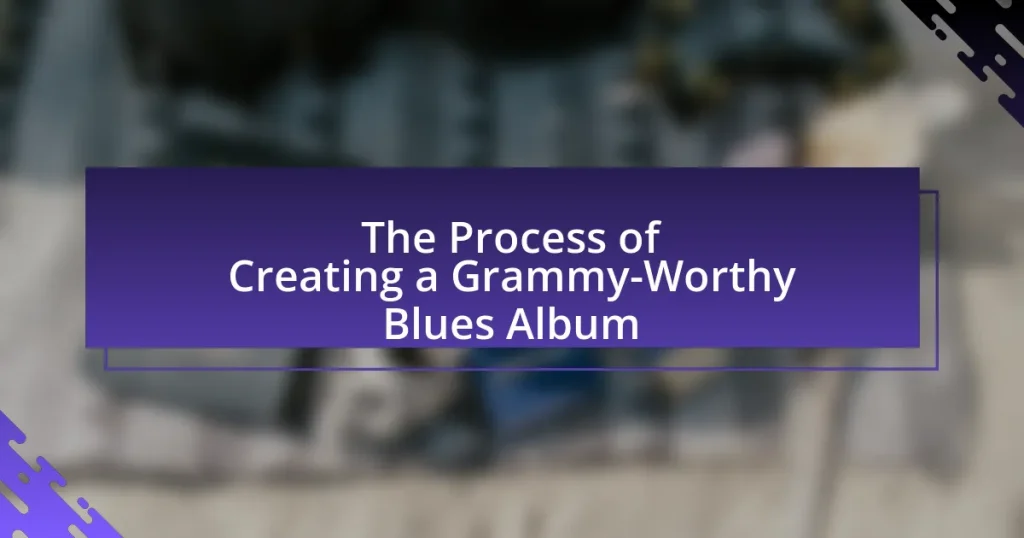The article analyzes the best blues albums of the 21st century, focusing on their innovative sound, lyrical depth, and cultural impact. It explores the evolution of the blues genre, highlighting how contemporary artists blend traditional elements with modern influences, and discusses key characteristics of modern blues music. The article evaluates the criteria for determining the best albums, the influence of critical reviews, and the significance of sales and popularity. Additionally, it identifies influential blues artists, standout albums, and hidden gems, while providing insights on how listeners can engage with and support the blues genre today.
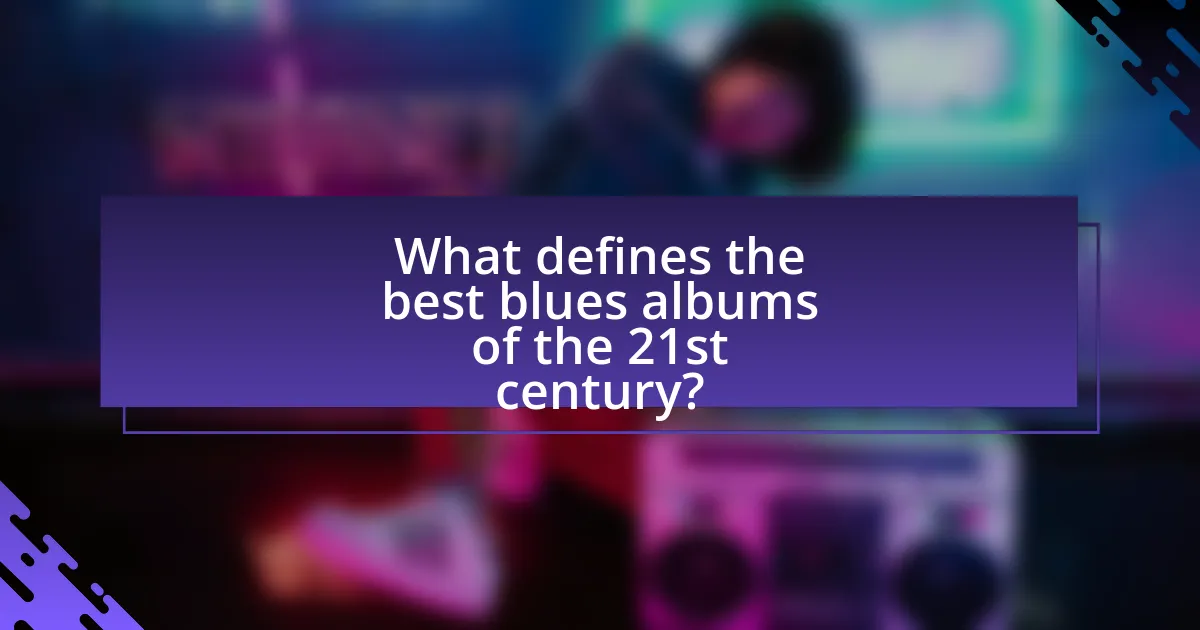
What defines the best blues albums of the 21st century?
The best blues albums of the 21st century are defined by their innovative sound, lyrical depth, and cultural impact. These albums often blend traditional blues elements with contemporary influences, showcasing artists’ ability to evolve the genre while maintaining its roots. For instance, albums like “Get Up!” by Ben Harper and “Blues of Desperation” by Joe Bonamassa have received critical acclaim for their musicianship and emotional resonance, reflecting the ongoing relevance of blues music in modern society. Additionally, the recognition of these albums through awards, such as the Grammy Awards, further validates their significance in the blues genre.
How has the blues genre evolved in the 21st century?
The blues genre has evolved in the 21st century by incorporating diverse musical influences and embracing modern technology. Artists have blended traditional blues with elements of rock, hip-hop, and electronic music, resulting in a fusion that appeals to a broader audience. For instance, musicians like Gary Clark Jr. and Joe Bonamassa have successfully integrated rock and soul into their blues sound, while artists such as Alabama Shakes have introduced a more contemporary, genre-blurring approach. Additionally, the rise of digital platforms has enabled independent blues artists to reach global audiences, leading to a resurgence of interest in the genre. This evolution is evidenced by the increasing number of blues albums that incorporate varied instrumentation and production techniques, reflecting the genre’s adaptability and relevance in today’s music landscape.
What are the key characteristics of modern blues music?
Modern blues music is characterized by its fusion of traditional blues elements with contemporary influences, including rock, jazz, and soul. This genre often features electric guitar riffs, expressive vocals, and a strong emphasis on emotional storytelling. Additionally, modern blues incorporates diverse instrumentation and production techniques, reflecting advancements in technology and musical styles. Artists frequently experiment with song structures and lyrical themes, addressing current social issues while maintaining the genre’s roots in personal experience and hardship. The evolution of blues can be seen in the works of artists like Joe Bonamassa and Gary Clark Jr., who blend classic blues with modern rock sensibilities, showcasing the genre’s adaptability and relevance in today’s music scene.
How do contemporary blues artists differ from their predecessors?
Contemporary blues artists differ from their predecessors primarily through their incorporation of diverse musical influences and modern technology. While traditional blues focused on a specific structure and themes rooted in African American history, contemporary artists blend genres such as rock, hip-hop, and jazz, creating a more eclectic sound. For instance, artists like Gary Clark Jr. and Joe Bonamassa utilize electric guitar techniques and production styles that reflect current trends, contrasting with the acoustic roots of early blues musicians like Robert Johnson. Additionally, contemporary artists often leverage digital platforms for distribution and promotion, allowing for broader reach and audience engagement compared to the limited channels available to earlier blues artists.
What criteria are used to evaluate the best blues albums?
The criteria used to evaluate the best blues albums include musical composition, lyrical depth, vocal performance, instrumental proficiency, production quality, and cultural impact. Musical composition assesses the originality and structure of the songs, while lyrical depth examines the storytelling and emotional resonance of the lyrics. Vocal performance evaluates the expressiveness and technical skill of the singer, and instrumental proficiency looks at the musicians’ technical abilities and creativity. Production quality considers the clarity and overall sound of the album, and cultural impact measures how the album influences the blues genre and resonates with audiences. These criteria are commonly referenced in music reviews and industry analyses, such as those found in publications like Rolling Stone and Billboard, which often highlight these aspects when ranking albums.
How do critical reviews influence the perception of blues albums?
Critical reviews significantly shape the perception of blues albums by providing authoritative evaluations that can enhance or diminish an album’s reputation. When critics highlight an album’s artistic merit, technical proficiency, or emotional depth, it can lead to increased interest and sales, as seen with albums like “Blues and Lonesome” by The Rolling Stones, which received widespread acclaim and subsequently topped charts. Conversely, negative reviews can deter listeners, as evidenced by the lukewarm reception of certain contemporary blues albums that failed to resonate with critics, resulting in lower visibility and sales. Thus, critical reviews serve as a crucial filter through which audiences assess the quality and relevance of blues music in the 21st century.
What role do sales and popularity play in determining the best albums?
Sales and popularity significantly influence the determination of the best albums, as they often reflect consumer demand and cultural impact. High sales figures indicate widespread acceptance and commercial success, while popularity, measured through charts and streaming metrics, showcases an album’s resonance with audiences. For instance, albums that achieve multi-platinum status, such as “Back in Black” by AC/DC, not only demonstrate strong sales but also often receive critical acclaim, reinforcing their status as some of the best in their genre. Thus, both sales and popularity serve as key indicators of an album’s significance in the music landscape.
Who are the most influential blues artists of the 21st century?
The most influential blues artists of the 21st century include Joe Bonamassa, Susan Tedeschi, Derek Trucks, and Gary Clark Jr. Joe Bonamassa has gained recognition for his virtuosic guitar skills and prolific output, releasing numerous acclaimed albums that blend traditional blues with rock elements. Susan Tedeschi and Derek Trucks, as a duo, have revitalized the blues genre with their band, Tedeschi Trucks Band, which has received multiple Grammy Awards and critical acclaim for their innovative sound. Gary Clark Jr. has emerged as a significant figure by merging blues with rock, soul, and R&B, earning a Grammy Award and widespread recognition for his dynamic performances and songwriting. These artists have not only shaped contemporary blues but have also influenced a new generation of musicians.
What contributions have these artists made to the blues genre?
These artists have significantly shaped the blues genre by introducing innovative styles, techniques, and themes that resonate with contemporary audiences. For instance, artists like Joe Bonamassa have blended traditional blues with rock elements, expanding the genre’s reach and appeal. Additionally, Gary Clark Jr. has incorporated elements of soul and R&B, creating a fusion that attracts a diverse fan base. Furthermore, artists such as Susan Tedeschi and Derek Trucks have revitalized the blues through their dynamic performances and collaborations, showcasing the genre’s versatility. Their contributions not only honor the roots of blues but also push its boundaries, ensuring its relevance in the 21st century.
How have collaborations shaped the sound of modern blues?
Collaborations have significantly shaped the sound of modern blues by blending diverse musical influences and styles. Notable partnerships, such as those between blues artists and musicians from genres like rock, jazz, and hip-hop, have introduced new elements to traditional blues, resulting in innovative sounds. For instance, the collaboration between Gary Clark Jr. and Eric Clapton on the album “Live in San Diego” showcases a fusion of blues with rock and soul, highlighting how cross-genre partnerships can enhance the emotional depth and complexity of blues music. Additionally, the collaboration between Joe Bonamassa and Beth Hart on “Seesaw” exemplifies how vocal interplay and varied instrumentation can create a fresh take on classic blues themes. These collaborations not only expand the audience for blues music but also encourage experimentation, leading to a richer and more dynamic sound in the genre.
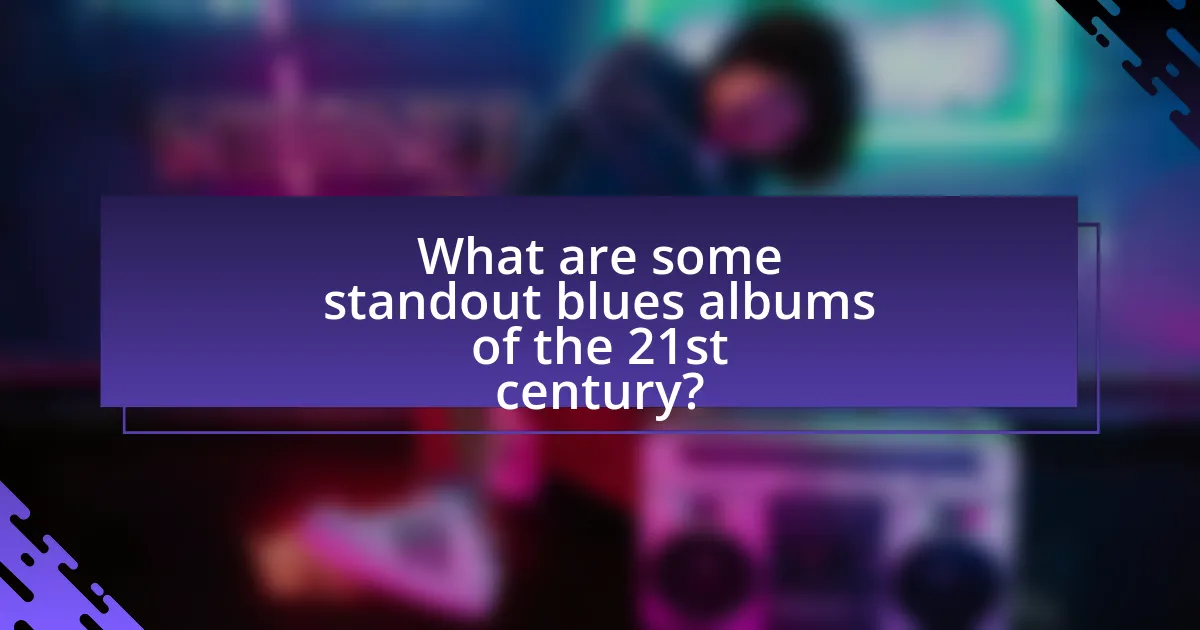
What are some standout blues albums of the 21st century?
Some standout blues albums of the 21st century include “Get Up!” by Ben Harper and Charlie Musselwhite, released in 2013, which won a Grammy Award for Best Blues Album. Another notable album is “Blues of Desperation” by Joe Bonamassa, released in 2016, showcasing his exceptional guitar skills and songwriting. Additionally, “The Last Days of Oakland” by Fantastic Negrito, released in 2016, received critical acclaim for its innovative blend of blues, rock, and funk, winning a Grammy for Best Contemporary Blues Album. These albums exemplify the evolution and diversity of the blues genre in the 21st century.
Which albums have received critical acclaim?
Albums that have received critical acclaim in the blues genre during the 21st century include “Blues Funeral” by Mark Lanegan, “Get Up!” by Ben Harper and Charlie Musselwhite, and “The Last Days of Oakland” by Fantastic Negrito. “Blues Funeral” was praised for its innovative blend of blues and rock elements, receiving high ratings from publications like Pitchfork. “Get Up!” won a Grammy Award for Best Blues Album, highlighting its recognition within the industry. “The Last Days of Oakland” garnered acclaim for its socially conscious lyrics and unique sound, earning a Grammy Award as well. These albums exemplify the evolution and diversity of blues music in recent years.
What makes these albums significant in the blues landscape?
These albums are significant in the blues landscape due to their innovative approaches and contributions to the genre’s evolution. They incorporate diverse influences, blending traditional blues elements with modern styles, which reflects the genre’s adaptability. For instance, albums like “Guitar Slinger” by Joe Bonamassa showcase technical prowess and songwriting depth, while artists such as Gary Clark Jr. infuse rock and soul, attracting a broader audience. This cross-genre appeal not only revitalizes interest in blues but also ensures its relevance in contemporary music. Additionally, the critical acclaim and commercial success of these albums, evidenced by awards and chart positions, further solidify their importance in shaping the future of blues music.
How do these albums reflect the themes of contemporary society?
These albums reflect the themes of contemporary society by addressing social issues such as inequality, personal struggles, and resilience. For instance, many tracks explore the impact of economic hardship and systemic racism, mirroring the ongoing discussions in society about social justice and equity. The lyrics often draw from personal experiences that resonate with listeners facing similar challenges, thus creating a sense of community and shared understanding. Additionally, the incorporation of modern production techniques and diverse influences showcases the evolution of blues as a genre that adapts to current cultural contexts, reinforcing its relevance in today’s music landscape.
What albums have achieved commercial success?
Albums that have achieved commercial success in the blues genre during the 21st century include “Back to Black” by Amy Winehouse, which has sold over 16 million copies worldwide, and “Born to Sing: No Plan B” by Van Morrison, which debuted at number one on the UK Albums Chart. Additionally, “Blues of Desperation” by Joe Bonamassa reached number one on the Billboard Blues Albums chart and has been critically acclaimed. These albums exemplify significant sales figures and chart performance, validating their commercial success in the blues category.
How do sales figures correlate with artistic merit in blues albums?
Sales figures do not consistently correlate with artistic merit in blues albums, as commercial success often reflects marketing and audience trends rather than the quality of the music. For instance, albums like “Born Under a Bad Sign” by Albert King, which is critically acclaimed for its artistic depth, did not achieve high sales compared to more commercially successful but less artistically significant albums. Additionally, the Grammy Awards often recognize artistic merit, yet many award-winning blues albums, such as “Get Up!” by Buddy Guy, may not have reached significant sales figures. This indicates that while there can be overlap, sales figures are influenced by factors such as promotion, timing, and market demand, rather than being a definitive measure of artistic quality.
What impact does commercial success have on an artist’s career?
Commercial success significantly enhances an artist’s career by increasing visibility, attracting larger audiences, and providing financial stability. When an artist achieves commercial success, they often gain access to better marketing opportunities, higher-profile collaborations, and increased media attention, which can lead to a sustained career. For instance, artists like B.B. King and Susan Tedeschi have seen their careers flourish due to successful album sales and widespread recognition, allowing them to tour extensively and reach new fans. This cycle of success reinforces their brand and solidifies their place in the music industry.
What are some hidden gems in the 21st-century blues scene?
Some hidden gems in the 21st-century blues scene include artists like Joe Bonamassa, who has released critically acclaimed albums such as “Blues of Desperation” (2016), showcasing his guitar prowess and songwriting skills. Another notable mention is Samantha Fish, whose album “Chills & Fever” (2017) blends blues with rock and Americana, earning her recognition in the genre. Additionally, the band The Record Company, with their album “Give It Back to You” (2016), has been praised for its raw sound and modern take on blues. These artists exemplify the innovative spirit of contemporary blues while maintaining its traditional roots.
How can listeners discover lesser-known but impactful blues albums?
Listeners can discover lesser-known but impactful blues albums by exploring curated playlists on streaming platforms, engaging with blues-focused blogs, and participating in online forums dedicated to the genre. Streaming services like Spotify and Apple Music often feature playlists that highlight hidden gems alongside popular tracks, making it easier for listeners to find quality albums that may not have mainstream recognition. Additionally, blogs such as Blues Blast Magazine and websites like AllMusic provide reviews and recommendations that spotlight underrated artists and albums. Online communities, including Reddit’s r/blues, allow fans to share their discoveries and discuss lesser-known works, further enriching the listener’s experience and knowledge of the blues genre.
What qualities make these albums worth exploring?
The qualities that make these albums worth exploring include their innovative sound, emotional depth, and cultural significance. Innovative sound is evident in the blending of traditional blues with contemporary genres, which attracts a diverse audience. Emotional depth is showcased through powerful lyrics and expressive performances that resonate with listeners, often reflecting personal and societal struggles. Cultural significance is highlighted by the way these albums contribute to the evolution of the blues genre, influencing new artists and preserving its rich history. For instance, albums like “Blues and Lonesome” by The Rolling Stones not only pay homage to classic blues but also introduce it to a new generation, demonstrating the genre’s ongoing relevance.

How can listeners appreciate and engage with 21st-century blues albums?
Listeners can appreciate and engage with 21st-century blues albums by actively exploring the diverse styles and themes presented in these works. Engaging with the lyrics allows listeners to connect emotionally with the artists’ experiences, while analyzing the instrumentation and production techniques reveals the evolution of the genre. For instance, albums like Gary Clark Jr.’s “Blak and Blu” showcase a blend of traditional blues with rock and soul influences, highlighting the genre’s adaptability. Additionally, attending live performances or virtual concerts enhances the experience, as it provides a deeper understanding of the artists’ interpretations and the communal aspect of blues music.
What are the best ways to listen to blues music?
The best ways to listen to blues music include streaming services, vinyl records, live performances, and curated playlists. Streaming services like Spotify and Apple Music offer extensive blues catalogs, allowing listeners to explore various artists and albums easily. Vinyl records provide an authentic listening experience, enhancing the warmth and depth of blues music. Live performances at blues clubs or festivals create an immersive atmosphere, connecting audiences directly with the artists. Curated playlists on platforms like YouTube or Spotify highlight essential tracks and emerging talents, making it easier for listeners to discover new favorites.
How does the listening environment affect the blues experience?
The listening environment significantly enhances the blues experience by influencing emotional engagement and auditory perception. Factors such as acoustics, ambiance, and social context can amplify the emotional depth of blues music, which often conveys themes of sorrow and resilience. For instance, a live performance in an intimate venue allows for a direct connection between the artist and the audience, fostering a shared emotional experience that can intensify the impact of the music. Research indicates that environments with rich acoustics can enhance the clarity and warmth of sound, making the emotional nuances of blues more palpable. Additionally, social settings, such as gatherings with fellow blues enthusiasts, can create a communal atmosphere that deepens the appreciation and understanding of the genre’s cultural significance.
What role do live performances play in appreciating blues music?
Live performances are crucial for appreciating blues music as they provide an authentic experience that captures the genre’s emotional depth and improvisational nature. The energy of a live setting allows audiences to connect with the musicians and the music on a personal level, enhancing their understanding of the blues’ cultural significance. Research indicates that live performances foster a communal atmosphere, where shared experiences amplify emotional responses, making the music more impactful. Additionally, the spontaneity of live shows showcases the musicians’ skills and creativity, which are essential elements of blues music, further enriching the listener’s appreciation.
How can fans support blues artists today?
Fans can support blues artists today by purchasing their music and merchandise directly from their official websites or platforms like Bandcamp. This direct financial support ensures that a larger portion of the revenue goes to the artists, as streaming services often pay minimal royalties. Additionally, attending live performances and promoting these events on social media increases visibility and helps sustain the artists’ careers. According to a 2021 report by the Music Industry Association, live music remains a significant revenue source for artists, particularly in genres like blues, where touring is essential for income.
What are effective ways to promote and share blues music?
Effective ways to promote and share blues music include utilizing social media platforms, organizing live performances, and collaborating with influencers in the music industry. Social media platforms like Facebook, Instagram, and TikTok allow artists to reach a wider audience through targeted advertising and engaging content, which can increase visibility and fan interaction. Live performances at local venues or festivals create opportunities for direct engagement with audiences, fostering a community around the music. Collaborating with influencers or established artists can leverage their fan base, introducing blues music to new listeners. According to a 2021 report by the International Federation of the Phonographic Industry, social media is a key driver for music discovery, with 50% of music listeners using platforms to find new artists.
How can attending blues festivals enhance the appreciation of the genre?
Attending blues festivals enhances appreciation of the genre by providing immersive experiences that showcase live performances, artist interactions, and cultural context. These festivals often feature a diverse lineup of established and emerging blues artists, allowing attendees to witness the evolution of the genre and its various substyles. For example, festivals like the Chicago Blues Festival and the New Orleans Jazz & Heritage Festival highlight the historical roots and contemporary expressions of blues music, fostering a deeper understanding of its significance. Engaging with fellow fans and participating in workshops further enriches the experience, as attendees can discuss techniques, influences, and the emotional depth of the music, ultimately leading to a more profound appreciation of blues as an art form.
What resources are available for exploring blues music further?
To explore blues music further, one can utilize various resources such as books, documentaries, online courses, and music streaming platforms. Notable books include “The Blues: A Very Short Introduction” by Elijah Wald, which provides a concise overview of the genre’s history and evolution. Documentaries like “The Blues” by Martin Scorsese offer in-depth insights into the lives of influential blues artists and the cultural impact of the music. Online platforms such as Coursera and MasterClass provide courses on blues music, taught by experts in the field. Additionally, music streaming services like Spotify and Apple Music feature curated playlists and albums that highlight significant blues recordings, allowing listeners to discover both classic and contemporary artists.
What online platforms offer access to blues albums and artists?
Online platforms that offer access to blues albums and artists include Spotify, Apple Music, Amazon Music, Tidal, and YouTube Music. These platforms provide extensive libraries featuring a wide range of blues music, from classic artists to contemporary musicians. For instance, Spotify boasts curated playlists and personalized recommendations that highlight blues genres, while Apple Music offers exclusive releases and artist interviews. Additionally, Amazon Music features a vast collection of blues albums available for streaming and purchase, and Tidal emphasizes high-fidelity audio quality for music enthusiasts. YouTube Music allows users to explore music videos and live performances, further enriching the blues listening experience.
How can educational materials deepen understanding of blues music?
Educational materials can deepen understanding of blues music by providing historical context, musical theory, and cultural significance. For instance, textbooks and documentaries often explore the origins of blues music in African American communities, detailing its evolution from spirituals and work songs. Additionally, instructional videos and online courses can break down the musical structure of blues, highlighting key elements such as the 12-bar blues progression and the use of improvisation. Research indicates that engaging with these materials enhances comprehension; a study by the University of Southern California found that students who utilized comprehensive music education resources demonstrated a 30% increase in their ability to analyze and appreciate various music genres, including blues.
